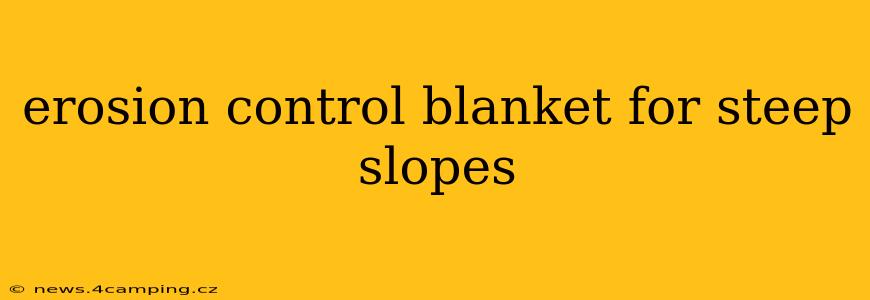Steep slopes present unique challenges for erosion control. The combination of gravity and often-sparse vegetation makes them highly susceptible to soil loss and landslides. Erosion control blankets offer a robust solution, providing a protective layer that stabilizes the soil and promotes vegetation growth. This comprehensive guide explores the various types of erosion control blankets, their applications on steep slopes, and factors to consider when selecting the right one for your project.
What are Erosion Control Blankets?
Erosion control blankets are engineered textiles designed to prevent soil erosion on slopes, embankments, and other vulnerable areas. They work by:
- Protecting the soil surface: The blanket acts as a physical barrier against rainfall impact and surface runoff, reducing soil detachment.
- Promoting vegetation growth: Many blankets incorporate biodegradable materials that provide nutrients and retain moisture, creating a favorable environment for seeds to germinate and grow.
- Stabilizing the soil: The blanket's structure interlocks with the soil, increasing its strength and resistance to erosion.
- Filtering sediment: Some blankets can filter sediment from runoff, reducing water pollution.
Different types of blankets utilize various materials and techniques to achieve these goals.
Types of Erosion Control Blankets for Steep Slopes
Several types of erosion control blankets cater specifically to the needs of steep slopes. The best choice depends on the specific site conditions, including soil type, slope angle, climate, and vegetation requirements. Common types include:
- Jute Blankets: These natural fiber blankets are biodegradable and offer excellent water retention. Their relatively low tensile strength might limit their use on very steep slopes or in high-velocity flow areas.
- Coconut Coir Blankets: Similar to jute, these blankets provide excellent water retention and are biodegradable. They generally offer superior strength compared to jute, making them suitable for steeper slopes.
- Polyester Blankets: These synthetic blankets are highly durable and resistant to degradation. They're ideal for high-velocity flows and challenging environments, even on very steep slopes. However, they're not biodegradable.
- Hybrid Blankets: Combining natural and synthetic fibers, these blankets offer a balance of strength, water retention, and biodegradability. They're a versatile option for a range of slope conditions.
How to Install Erosion Control Blankets on Steep Slopes
Proper installation is crucial for the effectiveness of erosion control blankets. This often requires specialized equipment and expertise, particularly on very steep slopes. Key steps typically include:
- Site preparation: Clearing the site of debris and loose rocks.
- Ground stabilization (if needed): This might involve measures like tackifying the soil to improve adhesion.
- Blanket placement: Carefully unrolling and securing the blanket, ensuring complete coverage and proper overlap. Specialized anchoring techniques are usually employed on steep slopes.
- Seeding and mulching (if applicable): This promotes rapid vegetation establishment, further stabilizing the soil.
What are the Benefits of Using Erosion Control Blankets on Steep Slopes?
The benefits of using erosion control blankets on steep slopes are numerous:
- Reduced soil erosion: This protects valuable topsoil and prevents sedimentation of waterways.
- Improved slope stability: This minimizes the risk of landslides and other slope failures.
- Enhanced vegetation establishment: This leads to long-term slope stabilization and improved aesthetics.
- Reduced maintenance: Compared to other erosion control methods, blankets often require less ongoing maintenance.
- Cost-effective: While the initial cost might be higher than some methods, the long-term benefits often outweigh the upfront investment.
What Factors Should I Consider When Choosing an Erosion Control Blanket?
Several factors are crucial for selecting the appropriate blanket:
- Slope angle and length: Steeper slopes require stronger and more durable blankets.
- Soil type and conditions: The blanket should be compatible with the soil and local climate.
- Rainfall intensity and runoff: High rainfall necessitates blankets with high water retention and filtration capabilities.
- Vegetation requirements: The blanket should support the growth of desired plant species.
- Project budget and timeline: Balancing cost and performance is essential.
How Long Do Erosion Control Blankets Last?
The lifespan of an erosion control blanket varies depending on the type of blanket, environmental conditions, and installation quality. Biodegradable blankets will naturally decompose over time (typically 1-3 years), while synthetic blankets can last for several years or even longer.
Are Erosion Control Blankets Environmentally Friendly?
Many erosion control blankets utilize biodegradable natural fibers, making them environmentally friendly. Even synthetic options contribute to environmental protection by preventing soil erosion and water pollution. However, it's crucial to choose a blanket that aligns with your specific environmental goals.
How Much Do Erosion Control Blankets Cost?
The cost of erosion control blankets varies greatly depending on the type of blanket, size, and quantity needed. It's best to get quotes from several suppliers to compare prices. Factors like installation costs should also be considered in the overall project budget.
This comprehensive guide provides a solid foundation for understanding erosion control blankets and their application on steep slopes. Remember to consult with experienced professionals to select and install the most appropriate blanket for your specific project needs. Proper planning and execution are key to ensuring long-term slope stability and environmental protection.
